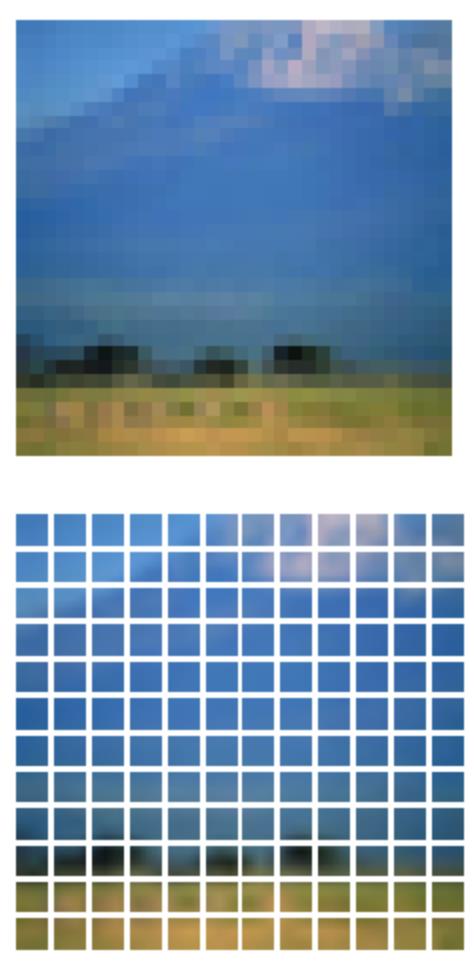手把手教你搭建神经网络(使用Vision Transformer进行图像分类)
Posted 羽峰码字
tags:
篇首语:本文由小常识网(cha138.com)小编为大家整理,主要介绍了手把手教你搭建神经网络(使用Vision Transformer进行图像分类)相关的知识,希望对你有一定的参考价值。

大家好,我是羽峰,今天要和大家分享的是一个基于Vision Transformer的图像分类研究。文章会把整个代码进行分割讲解,完整看完,相信你一定会有所收获。
欢迎关注“羽峰码字”
目录
1. 介绍
本示例实现了Alexey Dosovitskiy等人的 Vision Transformer (ViT) 模型。 该模型主要功能是进行图像分类,使用CIFAR-100数据集进行复现。 ViT模型可将Transformer体系结构自觉地应用于图像补丁序列,而无需使用卷积层。
此示例需要TensorFlow 2.4或更高版本以及TensorFlow Addons,可以使用以下命令进行安装:
pip install -U tensorflow-addons2. 前期准备
2.1 一些基本API
import numpy as np
import tensorflow as tf
from tensorflow import keras
from tensorflow.keras import layers
import tensorflow_addons as tfa2.2 一些超参数的配置
learning_rate = 0.001
weight_decay = 0.0001
batch_size = 256
num_epochs = 100
image_size = 72 # We'll resize input images to this size
patch_size = 6 # Size of the patches to be extract from the input images
num_patches = (image_size // patch_size) ** 2
projection_dim = 64
num_heads = 4
transformer_units = [
projection_dim * 2,
projection_dim,
] # Size of the transformer layers
transformer_layers = 8
mlp_head_units = [2048, 1024] # Size of the dense layers of the final classifier3. 数据
3.1 准备数据
num_classes = 100
input_shape = (32, 32, 3)
(x_train, y_train), (x_test, y_test) = keras.datasets.cifar100.load_data()
print(f"x_train shape: x_train.shape - y_train shape: y_train.shape")
print(f"x_test shape: x_test.shape - y_test shape: y_test.shape")x_train shape: (50000, 32, 32, 3) - y_train shape: (50000, 1) x_test shape: (10000, 32, 32, 3) - y_test shape: (10000, 1)
3.2 数据扩充
data_augmentation = keras.Sequential(
[
layers.experimental.preprocessing.Normalization(),
layers.experimental.preprocessing.Resizing(image_size, image_size),
layers.experimental.preprocessing.RandomFlip("horizontal"),
layers.experimental.preprocessing.RandomRotation(factor=0.02),
layers.experimental.preprocessing.RandomZoom(
height_factor=0.2, width_factor=0.2
),
],
name="data_augmentation",
)
# Compute the mean and the variance of the training data for normalization.
data_augmentation.layers[0].adapt(x_train)4. 多层感知器(MLP)
def mlp(x, hidden_units, dropout_rate):
for units in hidden_units:
x = layers.Dense(units, activation=tf.nn.gelu)(x)
x = layers.Dropout(dropout_rate)(x)
return x5. 将patch创建实施为一层
class Patches(layers.Layer):
def __init__(self, patch_size):
super(Patches, self).__init__()
self.patch_size = patch_size
def call(self, images):
batch_size = tf.shape(images)[0]
patches = tf.image.extract_patches(
images=images,
sizes=[1, self.patch_size, self.patch_size, 1],
strides=[1, self.patch_size, self.patch_size, 1],
rates=[1, 1, 1, 1],
padding="VALID",
)
patch_dims = patches.shape[-1]
patches = tf.reshape(patches, [batch_size, -1, patch_dims])
return patches让我们显示示例图像的patch
import matplotlib.pyplot as plt
plt.figure(figsize=(4, 4))
image = x_train[np.random.choice(range(x_train.shape[0]))]
plt.imshow(image.astype("uint8"))
plt.axis("off")
resized_image = tf.image.resize(
tf.convert_to_tensor([image]), size=(image_size, image_size)
)
patches = Patches(patch_size)(resized_image)
print(f"Image size: image_size X image_size")
print(f"Patch size: patch_size X patch_size")
print(f"Patches per image: patches.shape[1]")
print(f"Elements per patch: patches.shape[-1]")
n = int(np.sqrt(patches.shape[1]))
plt.figure(figsize=(4, 4))
for i, patch in enumerate(patches[0]):
ax = plt.subplot(n, n, i + 1)
patch_img = tf.reshape(patch, (patch_size, patch_size, 3))
plt.imshow(patch_img.numpy().astype("uint8"))
plt.axis("off")Image size: 72 X 72 Patch size: 6 X 6 Patches per image: 144 Elements per patch: 108

6 实现patch编码层
PatchEncoder层将通过将patch投影到大小为projection_dim的向量中来线性地对其进行变换。 此外,它还向嵌入的向量中添加了可学习的位置。
class PatchEncoder(layers.Layer):
def __init__(self, num_patches, projection_dim):
super(PatchEncoder, self).__init__()
self.num_patches = num_patches
self.projection = layers.Dense(units=projection_dim)
self.position_embedding = layers.Embedding(
input_dim=num_patches, output_dim=projection_dim
)
def call(self, patch):
positions = tf.range(start=0, limit=self.num_patches, delta=1)
encoded = self.projection(patch) + self.position_embedding(positions)
return encoded7.建立ViT模型
ViT模型由多个Transformer模块组成,这些模块使用layer.MultiHeadAttention层作为应用于补丁(patch)序列的自注意力机制。 Transformer块产生一个[batch_size,num_patches,projection_dim]张量,该张量通过带有softmax的分类器头进行处理以产生最终的类概率输出。
与 paper中描述的技术不同,后者将可学习的嵌入添加到已编码补丁的序列中以用作图像表示,最终Transformer块的所有输出均经过layer.Flatten()整形并用作输入的图像表示。请注意,也可以改用layers.GlobalAveragePooling1D图层来聚合Transformer块的输出,尤其是在色块数量和投影尺寸较大的情况下。
def create_vit_classifier():
inputs = layers.Input(shape=input_shape)
# Augment data.
augmented = data_augmentation(inputs)
# Create patches.
patches = Patches(patch_size)(augmented)
# Encode patches.
encoded_patches = PatchEncoder(num_patches, projection_dim)(patches)
# Create multiple layers of the Transformer block.
for _ in range(transformer_layers):
# Layer normalization 1.
x1 = layers.LayerNormalization(epsilon=1e-6)(encoded_patches)
# Create a multi-head attention layer.
attention_output = layers.MultiHeadAttention(
num_heads=num_heads, key_dim=projection_dim, dropout=0.1
)(x1, x1)
# Skip connection 1.
x2 = layers.Add()([attention_output, encoded_patches])
# Layer normalization 2.
x3 = layers.LayerNormalization(epsilon=1e-6)(x2)
# MLP.
x3 = mlp(x3, hidden_units=transformer_units, dropout_rate=0.1)
# Skip connection 2.
encoded_patches = layers.Add()([x3, x2])
# Create a [batch_size, projection_dim] tensor.
representation = layers.LayerNormalization(epsilon=1e-6)(encoded_patches)
representation = layers.Flatten()(representation)
representation = layers.Dropout(0.5)(representation)
# Add MLP.
features = mlp(representation, hidden_units=mlp_head_units, dropout_rate=0.5)
# Classify outputs.
logits = layers.Dense(num_classes)(features)
# Create the Keras model.
model = keras.Model(inputs=inputs, outputs=logits)
return model8. 编译,训练和评估模型
def run_experiment(model):
optimizer = tfa.optimizers.AdamW(
learning_rate=learning_rate, weight_decay=weight_decay
)
model.compile(
optimizer=optimizer,
loss=keras.losses.SparseCategoricalCrossentropy(from_logits=True),
metrics=[
keras.metrics.SparseCategoricalAccuracy(name="accuracy"),
keras.metrics.SparseTopKCategoricalAccuracy(5, name="top-5-accuracy"),
],
)
checkpoint_filepath = "/tmp/checkpoint"
checkpoint_callback = keras.callbacks.ModelCheckpoint(
checkpoint_filepath,
monitor="val_accuracy",
save_best_only=True,
save_weights_only=True,
)
history = model.fit(
x=x_train,
y=y_train,
batch_size=batch_size,
epochs=num_epochs,
validation_split=0.1,
callbacks=[checkpoint_callback],
)
model.load_weights(checkpoint_filepath)
_, accuracy, top_5_accuracy = model.evaluate(x_test, y_test)
print(f"Test accuracy: round(accuracy * 100, 2)%")
print(f"Test top 5 accuracy: round(top_5_accuracy * 100, 2)%")
return history
vit_classifier = create_vit_classifier()
history = run_experiment(vit_classifier)
经过100个周期后,ViT模型的测试数据达到了约55%的精度和82%的top-5精度。 这些在CIFAR-100数据集上不是竞争性结果,因为从零开始对同一数据进行训练的ResNet50V2可以达到67%的准确度。
请注意,通过使用JFT-300M数据集对ViT模型进行预训练,然后在目标数据集上进行微调,可以实现paper 中报告的最新结果。 要在不进行预训练的情况下提高模型质量,您可以尝试对模型进行更多的训练,使用更多的Transformer图层,调整输入图像的大小,更改色块大小,或增加投影尺寸。 此外,如本文所述,模型的质量不仅受体系结构选择的影响,还受学习速率计划,优化器,权重衰减等参数的影响。在实践中,建议对ViT进行微调 使用大型高分辨率数据集进行预训练的模型。
至此,今天的分享结束了。强烈建议新手能按照上述步骤一步步实践下来,必有收获。
今天代码翻译于:https://keras.io/examples/vision/image_classification_with_vision_transformer/,新入门的小伙伴可以好好看看这个网站,很基础,很适合新手。
当然,这里不得不重点推荐一下这三个网站:
https://tensorflow.google.cn/tutorials/keras/classification
https://keras.io/examples
https://keras.io/zh/
其中keras中文网址中能找到各种API定义,都是中文通俗易懂,如果想看英文直接到https://keras.io/,就可以,这里也有很多案例,也是很基础明白。入门时可以看看。
我是羽峰,还在成长道路上摸爬滚打的小白,希望能够结识一起成长的你,公众号“羽峰码字”,欢迎来撩。
以上是关于手把手教你搭建神经网络(使用Vision Transformer进行图像分类)的主要内容,如果未能解决你的问题,请参考以下文章